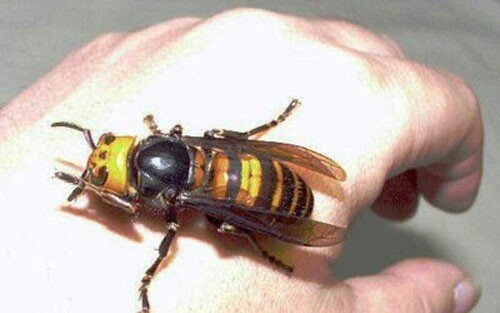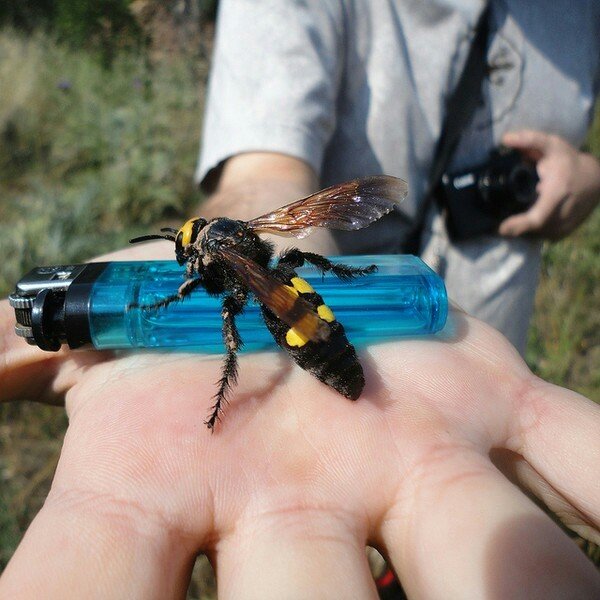Japanese huge hornet
You know, when I read about different insects sometimes I sigh with relief. As well, that nature has made them small and they do not pose a great danger to man, not all of course.

But today I wanted to tell you about the huge Japanese hornet.
Japanese huge bee horn, Insects, hornet, long-backpost
Here is his description: The Japanese giant hornet is a large public arthropod, reaching more than 4 cm in length with a wingspan of more than 6 cm. Therefore in Japan this animal has the name "Suzumabati" ("Sparrow-bee").
This hornet has a large yellow head with large eyes (and also three small additional eyes), a dark brown abdomen with brownish-yellow stripes.
Enough impressive size. More is just a giant wasp Scalia.

Its length, depending on the species, reaches up to 100 mm, the wingspan up to 60 mm
But now about the hornet.
The female ("queen", uterus) establishes a nest in which it lays eggs. From eggs hatch larvae, which must be fed. Then the larvae pupate, then adult puppies leave the pupa. So there is a colony, which is fed by working individuals (foragers).
Japanese hornets eat a variety of food - mainly insects, including pests of agriculture. Workers cut off the body of their victims in order to obtain valuable substances and meat from the chitinous cover. This food is fed to the larvae
But the most interesting thing, it seemed to me, was how they hunted bees: when the hornet-"scout" finds a beehive, he leaves a note near him. Then the "scout" informs other hornets about the find, and in a short time a large number of hornets flies to the hive and attack the bees.
Within three hours, Japanese hornets can destroy a whole beehive - 30 thousand bees. Then they dismember the bee brood, which they feed to their larvae. Hornets also eat honey from honeycombs. Usually about 30 hornets arrive for hunting.
30 hornets against 30,000 bees. Can you imagine this?
Bees have to somehow defend themselves. Therefore, they invented an interesting tactic: when a hornet scout flies to their hive, a tangle of about 500 bees immediately forms around the hornet. They surround the hornet with a huge tangle, within which the temperature can rise to 47 ° C. Since the bees are able to maintain and withstand up to 50 ° C, the hornet dies.
In case of danger, hornets attack people, for example, peasants who happened to be near a nest. Attack of hornets is very dangerous: their sting has a length of about 6.25 mm. It will release, when stung, a highly toxic poison of nerve agent, which destroys the tissues of the victim. Bites of the hornet are very painful, cause anaphylactic shock and require hospitalization. Mass bites are especially dangerous.
Hornets of this species kill an average of about 40 people a year - more than any other wild animal in Japan.
That bee vs hornet video is madness.